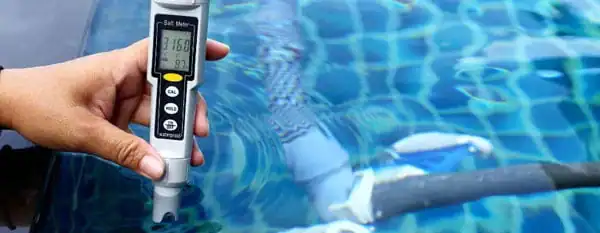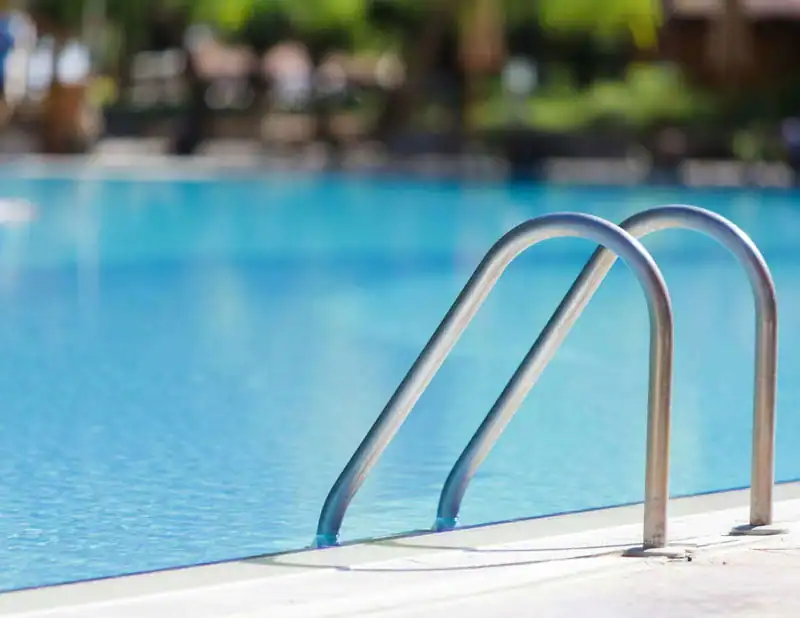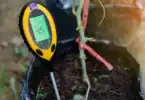Pool owners who are considering a saltwater pool conversion or are new to one often wonder how the process works and where does pool salt go? In this article, we explain the ‘salt cycle’ that is involved when you use a salt chlorine generator to sanitize your pool.
How Are Things Supposed to Work?
In a saltwater pool, the salt is added to supply chlorine for sanitization. This is an alternative to continually adding Chlorine to the pool to keep the water fresh & sanitary. But the salt alone just wants to be salty – the sodium stays attached to the chlorine. This is until the salt water goes through a device called a salt chlorine generator, or more commonly a salt cell. This device uses a small amount of electricity to the water within the cell, and a through a process of electrolysis, the sodium and chlorine are separated from each other.
Now the ‘free chlorine’ is available to do sanitization processes and the sodium remains in the water, waiting to recombine with passing chlorine. Eventually, the sodium and chlorine that are in the pool turn back into salt. This salt cycle is consider to be continuous – so the salt cell keeps separating the molecules and the molecules eventually turn back into salt. In the interim, the salt cell keeps generating enough chlorine to keep the water clean. Pretty neat, huh?
Where Does Pool Salt Go?
So the salt cycle is a continuous process, and in a perfectly operating pool, the salt levels stay stable over time without adding more salt.
However, people sometimes do experience the issue of the salt concentration decreasing, leading to our question. So what might make this happen?
- There is a slow leak somewhere in your pool system. As you replace fresh water that is lost to evaporation, you might not notice that you are adding more than usual.
- You forgot to put in the chlorine stabilizer (cyanuric acid) and/or you didn’t close the pool cover, so chlorine dissipates over time, which in turn uses up some of the salt in your system. For more about the affect of sunlight on chlorine, see Do The Heat & Sun Affect Pool Chlorine?
- The kids are splashing each other again and some of it is running into the shrubs. I know you told them not to do it, but kids are kids.
- You had a big rain storm and some of the pool water ran down the overflow drain or over the edge of the pool if the overflow got blocked.
- You had to backwash the filtering system, and the flushed salt water went down the drain as a result.
In any case, if you find that your salt concentration is slowly diminishing, you should look for the reason. The pool salt is not getting consumed by the system itself, even though it is continuously sanitizing your pool.
What is Pool Salt?
Pool salt is a specially prepared type of salt (sodium chloride) that is used in saltwater pools to produce chlorine and sanitize the water. It must be used in conjuction with a salt chlorine generator. For more information about types of Pool Salt, and selecting one for your pool, see Is All Pool Salt The Same? Understanding the Differences.
How to Add Pool Salt
To add pool salt to your pool, it is important to calculate the correct amount needed based on the size of your pool and what the current salt concentration is. For more about how to test for the salt level and our Pool Salt Calculator, see the article Saltwater Pools: How Much Salt For Proper Chlorination?
If you found this article and are still in the evaluation stage of choosing to use a salt chlorine generator instead of adding chemical chlorine, you might be interested in this article: Chlorine to Saltwater Pool Conversion: Can it be Done?
Remember, salt should be treated like any other pool chemical and should not be added when there are swimmers in the pool. It’s best to add salt when the pool is not in use. For more tips on saltwater pool maintenance, please see the last half of the article on Saltwater Pools: How Much Salt For Proper Chlorination?

Frequently Asked Questions
Can I Use Salt in My Pool without a Saltwater System?
Well – you could, but it won’t do anything for the sanitization of the pool water without also having a salt chlorine generator. You’d just have slightly salty water.
How Long After Adding Salt to Pool Can You Turn on Chlorinator?
After adding salt to your pool the first time, it is recommended to wait at least 24 hours before turning on your chlorinator. This allows the salt to dissolve completely and distribute evenly throughout the pool. Turning on your chlorinator too soon can cause the salt to settle at the bottom of the pool, leading to uneven distribution and potential damage to your equipment. If your salt is clumping and you can’t distribute it well around the pool, you should try to run the pump/jets to help the salt dissolve.
If you are just adjusting salt or water levels to balance your concentration, it’s fine to use the chlorine generator right away.
Should I Turn Off Chlorinator when Adding Salt?
Yes, it is recommended to turn off your chlorinator when adding salt to your pool. Chlorinators can be damaged by high levels of salt, so it is important to add salt to your pool slowly and in small increments. It is also good to distribute the salt that you are adding across a wide area of the water. Turning off your chlorinator during the process will prevent it from producing too much chlorine and potentially damaging your equipment.
How Often Should I Add Salt to a Pool?
It is usually recommended to check the salt concentration in your pool once a month. In general, you should also be checking other water quality factors such as free chlorine, alkalinity and pH. There are convenient test strips that can check the general levels of all of these factors with a single test strip. For more about that topic, see: Salt Of The Earth: How Accurate Are Pool Test Strips.
If your pool is operating as it should, you should not need to add salt very
Why Doesn’t My Water Taste Salty?
The amount of salt needed for a salt water pool is a fairly low concentration. Each gallon has less than 10% as much salt as ocean water. So some people might notice a salty quality, but others won’t. Most people do think that salt water pool water is gentler on their skin and eyes though, than a pool sanitized with chemical chlorine. You also will not experience your hair turning green.
Does a saltwater pool still need stabilizer (CYA)?
Yes, cyanuric acid is needed to protect chlorine from sunlight degradation. If you don’t use (or don’t want to use) cyanuric acid, you will need to monitor the salt levels more often and will need to use more salt as the chlorine dissipates. Another way to slow down the loss of chlorine from your pool is to use a pool cover when it’s not in use.
Why does my saltwater pool look green?
The most likely cause of water that looks green is algae growth. This is usually a sign of not enough chlorine. First check that you salt concentration is not low. If salt is available in the water, then it could be a sign of a problem with your salt generator system – possible that your salt cell is going bad. See Saltwater Pool Salt Cell Need Replacing? Here’s How To Tell for more information.
How long should I run the chlorine generator?
The chlorine system on your saltwater pool should run the entire time you are running the circulating pump system. If you find that you still are not generating enough free chlorine (a value you can get by using pool water test strips), you may need to extend the time that you run both systems.







